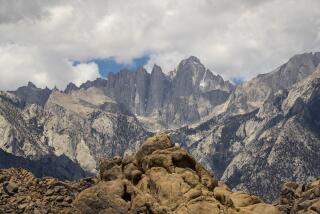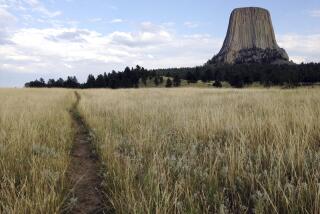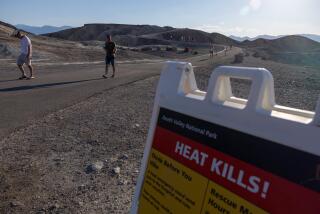Trapped Hiker Had One Way Out -- With His Knife
- Share via
ASPEN, Colo. — His right arm was pinned beneath an 800-pound boulder. His water bottle was empty. It did not seem likely that a rescue crew could ever spot him in the narrow slit of Blue John Canyon, in the wilds of southeast Utah.
So, after five days, Aron Ralston took out his pocketknife and amputated his arm below the elbow. Then he rigged anchors into the cliff, fixed a rope and rappelled 60 feet to the canyon floor. Bleeding heavily through a makeshift tourniquet, Ralston began to hike.
He had walked about five miles when a helicopter search team spotted him Thursday afternoon on a trail through Canyonlands National Park, drained and dehydrated -- but still pushing forward.
“That’s true grit,” park ranger Glenn Sherrill said.
On Friday, Ralston was recovering from surgery at a Colorado hospital. And his friends were predicting he would return to the mountain wilderness the first chance he gets.
“I expect him to be out there, doing everything he ever did,” nature photographer John Fielder said.
Ralston, 27, is an audacious mountaineer who has climbed 59 of the highest peaks in Colorado. A story this spring in his hometown paper, the Aspen Times, described him climbing alone, in midwinter, in the dead of night, without cell phone, radio, beacon or rope. A mechanical engineer by training, an explorer in spirit, Ralston relishes pushing his body over ice-slick cliffs. He delights in standing alone at a 14,000-foot summit as lightning crashes around him, as gray wolves howl from distant ledges.
The adventure that ended with his self-amputation was supposed to have been a modest one: a bike ride up a canyon, then a hike down through the sculpted sandstone bluffs on a bright spring Saturday. The round trip would take perhaps eight hours. Ralston thought so little of it, he didn’t bother to give his roommates a detailed itinerary, as was his practice on mountain climbs.
He completed the ride without incident and left his bike at the top, planning to drive up in his truck later to retrieve it. On the way down, he used rock-climbing equipment to navigate the narrow passages of Blue John Canyon -- which in places is just 3 feet wide. After an hour or two, he came to a giant boulder wedged in the canyon, according to Sherrill, the park ranger.
Ralston scrambled over the boulder and was lowering himself down when it shifted, pinning his arm. He managed to maneuver his feet so that he was standing upright. But he could not free himself.
Authorities said he used his climbing gear to rig a webbed sling so he could try to push the rock away with his feet. It was too heavy.
He stood there, trapped, for five days, during which temperatures dropped to 30 degrees.
On Tuesday, he ran out of water. On Thursday, he “realized that his survival required drastic action,” according to a statement by the sheriff’s office in Emery County, Utah. He used his pocketknife to free himself the only way he could, by cutting off part of his arm. Though such brutal surgery is hard to imagine, others in desperate straits have done it, managing to sever the muscles and tendons that attach limbs to joints with a modest jackknife.
It is unclear whether Ralston hacked through his bone or whether the bone had been crushed by the boulder.
Once he had completed the job, he used his first-aid kit to tie a tourniquet around his bicep. Then he rappelled down the cliff -- and started walking.
“His instinct for survival was great,” Fielder said.
Hours later, Ralston met two hikers in Horseshoe Canyon. They gave him water and walked with him until they could flag down a helicopter from the Utah Department of Public Safety. Ralston’s co-workers had alerted the mountain rescue crews just that morning that he had not shown up for work all week.
“He was obviously in major distress, having cut his own arm off, but he was still ambulatory,” park ranger Jim Blazik said.
Ralston remained conscious through the brief helicopter ride to Allen Memorial Hospital in Moab, Utah, and walked into the emergency room on his own. He was later flown to St. Mary’s Hospital in Grand Junction, Colo.
Rescuers returned to the canyon later to try to retrieve the amputated limb; they saw it, but couldn’t budge the boulder.
“It’s a phenomenal story, but Aron is a phenomenal person,” said Tim Mutrie, the Aspen reporter who profiled Ralston.
Ralston underwent surgery Thursday night and is in serious condition in the intensive care unit. His “spirits are high and he anxiously looks forward to returning to his love of the outdoors,” his mother, Donna Ralston, said in a statement Friday.
Though relieved that Ralston survived, Blazik chided him for hiking through such rugged, remote terrain alone and without leaving a detailed itinerary with friends. “As far as I’m concerned, that was a foolish act, very, very unwisely done,” Blazik said, emphasizing that he was not speaking for the park service.
Ralston is accustomed to such criticism.
He has conquered all 59 of the Colorado peaks he counts as “Fourteeners,” summits of at least 14,000 feet, with names such as Challenger Point and Mount Massive. (Some climbers, using a different ranking method, count only 54 Fourteeners.)
Five years ago he set out to make history by climbing those summits again -- this time alone, in wintertime.
Veteran climbers have watched with a blend of awe and alarm as he has methodically scrambled up one after another, risking frostbite and worse as he pushes to the top, then signs his name triumphantly in the summit log. Because the risk of avalanche is greatest when the sun is out, he often climbs after midnight.
Only three climbers have ever reached the summit of every Fourteener in Colorado. None has done it solo. Ralston has 14 more to go.
Mutrie, who considers Ralston a friend, says the climber finds joy in tackling monster peaks without the oxygen canisters, satellite-guided tracking systems and communication gear that many mountaineers routinely pack. Stripped down to the bare essentials, Ralston pits himself against nature. “For him, it clarifies the goal,” Mutrie said.
An avalanche in February nearly buried Ralston alive as he skied backcountry with two friends; the experience sobered, but did not stop, him. Described by friends as soft-spoken and easygoing off the mountains, Ralston focused on his climbing goals with an intensity few could rival.
“He was trying to be one of the top mountaineers,” said Joe Wheadon, who shares a rented house with Ralston in Aspen. “That was what he wanted to do.”
Ralston graduated from Carnegie Mellon University in Pittsburgh with a double major in French and mechanical engineering and a minor in performance piano.
According to Mutrie’s story, he worked for several years designing “clean rooms” for microchip production. When his employer, Intel, wouldn’t give him three weeks off to climb Mt. McKinley, he quit.
“I could live out of my truck,” he told Mutrie. “That’s kind of an attractive lifestyle to me, actually.”
Instead, Ralston moved to Aspen, took a job in a mountaineering store and packed his truck for the wilderness every chance he got.
Alone with the elements, testing his strength and his savvy, pushing himself past every limit he thought he had, he thrives.
“To challenge yourself, to survive in what can often be hostile conditions -- it’s a very primal thing that people like Aron do,” his friend Fielder said.
“It’s all unnecessary,” Ralston told Mutrie, “but at the same time it’s entirely necessary for me. I wouldn’t lead a happy life doing anything other than what I’m doing. This is my ultimate contribution, whether anybody likes it or not. It’s my art.”
More to Read
Sign up for The Wild
We’ll help you find the best places to hike, bike and run, as well as the perfect silent spots for meditation and yoga.
You may occasionally receive promotional content from the Los Angeles Times.






